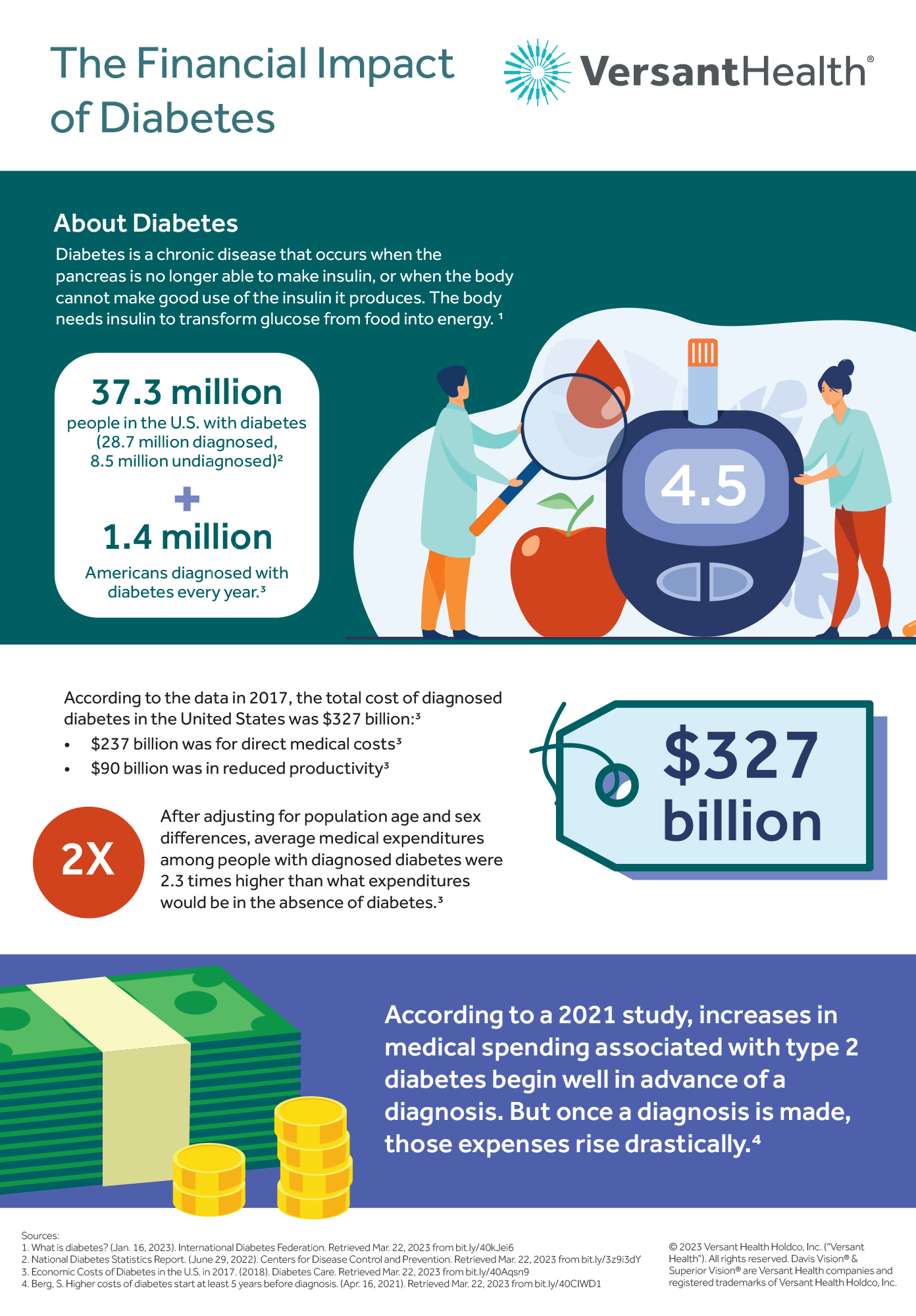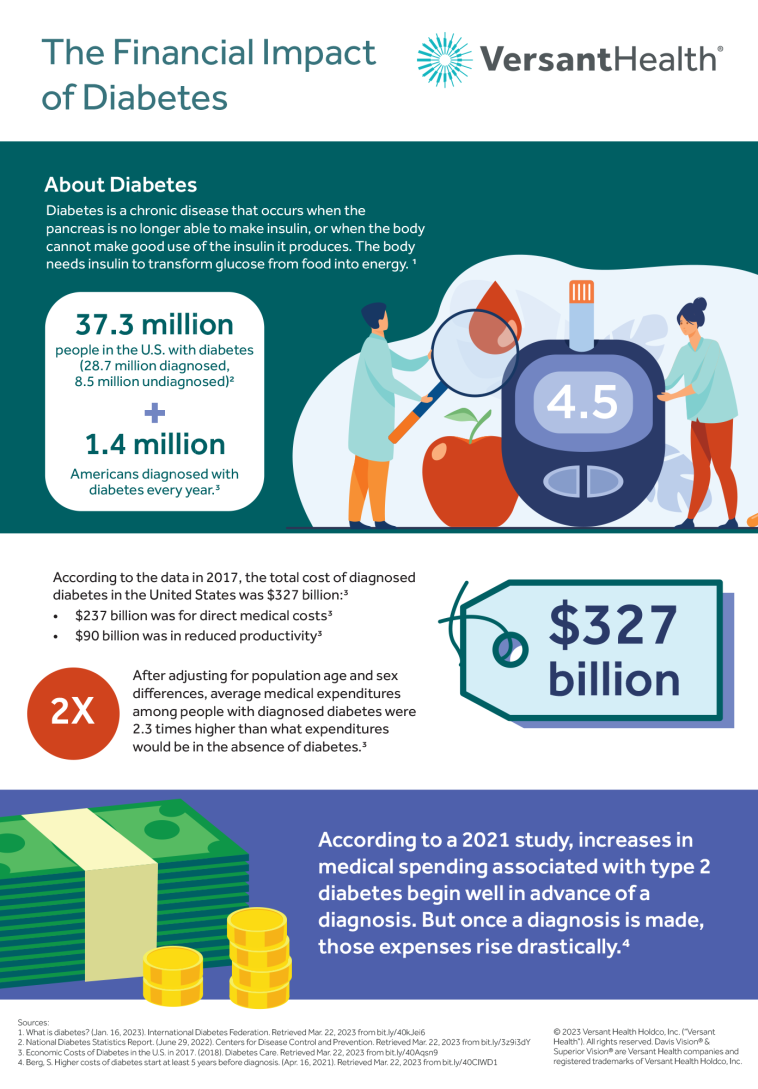
Diabetes and Financial Health: Unpacking Hidden Challenges and Economic Pressures
The recent study published in JAMA Network Open has sparked significant discussion among healthcare providers, policy experts, and patients alike. A closer look into the lives of individuals with type 2 diabetes reveals that they are more likely to face a host of adverse financial outcomes compared to those without the condition. In this opinion editorial, we examine the study’s findings, unpack the subtle details that contribute to economic hardship, and explore how a holistic treatment approach might help ease financial vulnerability.
For many living with type 2 diabetes, the management of a chronic condition is not merely a matter of balancing blood sugar levels—it is also about contending with tricky parts of personal finance. The study, which meticulously analyzed data from 166,285 adults who had at least one encounter at a primary care center between October 1, 2017, and December 31, 2021, reveals that patients with diabetes have significantly higher chances of facing financial difficulties. With estimated probabilities showing figures as high as 64.5% for adverse financial outcomes, the results demand that we take a closer look at the entwined factors of health and economic stability.
This editorial aims to dig into how chronic disease and financial strain are interlinked, what the research implies for everyday patients, and the potential role of a holistic approach in reducing these burdens. By examining the fine points of this study, we can better understand the turbulent financial landscape for individuals managing diabetes.
Understanding the Economic Impact: The Study in Focus
The research, led by Matthew Pesavento, Ph.D., from The Ohio State University, used electronic health records correlated with credit records as a basis for its statistical analysis. The study compared patients with type 2 diabetes with their non-diabetic counterparts and unearthed several key findings:
- Patients with diabetes had a 64.5% chance of encountering any adverse financial outcome compared with 49.9% for those without diabetes.
- The likelihood of having below-prime credit scores was estimated at 59.7% for diabetic patients versus 45.9% for their non-diabetic peers.
- Instances of medical and nonmedical collections, delinquent debt, debt charge-offs, bankruptcy filings, and even foreclosures were all significantly higher among those with diabetes.
This table summarizes some of the stark differences between the two groups:
| Financial Outcome | Patients with Diabetes (%) | Patients without Diabetes (%) |
|---|---|---|
| Adverse Financial Outcomes | 64.5 | 49.9 |
| Below-prime Credit Scores | 59.7 | 45.9 |
| Medical Collections | 36.9 | 23.9 |
| Nonmedical Collections | 38.4 | 27.7 |
| Delinquent Debt | 23.3 | 15.6 |
| Debt Charge-offs | 15.4 | 10.1 |
| Bankruptcy Filings | 2.1 | 1.4 |
| Foreclosures | 0.5 | 0.3 |
These differences underline that type 2 diabetes is intertwined with many financial twists and turns that can negatively affect everyday life. The disparities also emphasize that economic vulnerability is not uniformly distributed. The study found that patients who are Black, enrolled in Medicaid, of Hispanic ethnicity, younger than 65, without earned income, or of female sex are at an even higher risk of encountering these daunting financial challenges.
Exploring Financial Vulnerability: The Fine Points of Economic Strain
The study’s findings are not isolated numbers; they represent a much larger theme that is full of problems and tricky bits affecting millions of Americans. When we consider the economic pressure on individuals with diabetes, several key issues emerge:
Riddled With Financial Tension
Patients with diabetes often face a relentless cycle of medical expenses. Regular visits to healthcare providers, lab work, and medications all add to an already heavy financial load. When you add unexpected costs such as hospitalization or treatment for complications, the financial impact becomes overwhelming.
Tracking Debt and Credit Challenges
Credit scores acts as an important indicator of financial health. With a noticeably larger portion of diabetic patients facing below-prime scores, it is clear that the condition’s economic implications reach far beyond the healthcare system. Poor credit can lead to difficulties obtaining loans for homes or cars, further limiting the economic opportunities for affected individuals.
Social and Emotional Impact
The stress that emerges from juggling medical bills and everyday expenses can lead to tension within families and communities. Financial stress is known to impact mental health, creating a feedback loop where stress can worsen physical health, which in turn can lead to more medical bills and debts. This intertwined relationship is one of the trickier parts of managing chronic disease on multiple fronts.
In summary, while the clinical aspects of diabetes management are challenging enough, the additional layer of economic pressure converts what might be a manageable condition into one that is truly intimidating to many.
Taking a Closer Look at Holistic Treatment Approaches
The study’s authors suggest that holistic treatment strategies might help mitigate the financial challenges experienced by diabetic patients. It is important to note that holistic does not mean a substitute for traditional medical care but rather an additional supportive measure that addresses not just the body, but also lifestyle elements that can affect both health and finance.
Here are some ways in which holistic treatment might ease financial vulnerability:
- Nutritional Interventions: Focusing on a well-balanced and nutritious diet can improve diabetes management. Consistent blood sugar control may lead to fewer complications, potentially reducing costly hospitalizations and emergency treatments.
- Physical Activity Programs: Regular exercise is a must-have component of diabetes management. Community exercise programs and gym memberships, if supported by healthcare plans, can serve as preventive measures that in turn diminish the need for more expensive medical interventions.
- Stress Management: Stress-reduction techniques such as mindfulness meditation, yoga, and cognitive-behavioral therapy are essential tools. By lowering overall stress levels, patients may find that they face fewer financial pitfalls caused by health-related distress.
- Social Support Systems: Establishing networks that offer both emotional and practical financial advice can be a cornerstone of a comprehensive treatment plan. Support groups and community-based programs can offer guidance on budgeting, negotiating medical bills, and accessing financial aid.
In addition, integrated care models that connect primary care providers with financial counseling services can help patients figure a path through the maze of healthcare bills. These models are designed to treat the patient holistically, addressing the little details that make up the full picture of a person’s well-being.
Primary Care and the Role of Electronic Health & Credit Records
One intriguing aspect of the study is the use of electronic health records tied with credit records, which is a new way of getting into a patient’s multifaceted life. While there are ethical and privacy concerns to consider, the integration of these data sources offers a richer view of the financial landscape patients face.
This innovative approach highlights several key points:
- Data-Driven Insights: Linking medical records with financial records allows researchers to unearth patterns that might otherwise remain hidden. This method helps in identifying groups that are particularly vulnerable.
- Early Intervention Opportunities: Providers might use this data to spot early warning signs of financial distress. Once identified, a multi-disciplinary team could step in with financial counseling and additional support services.
- Resource Allocation: Understanding which patients are at higher risk for financial problems allows for better allocation of resources. It becomes possible to design targeted interventions that not only address health issues but also improve overall economic outcomes.
This method represents a significant shift from traditional healthcare practices. By recognizing the intertwined nature of health and financial stability, primary care providers can offer more personalized, comprehensive care that doesn’t just focus on disease management alone.
Reflecting on the Broader Implications for Healthcare Policy
As we take a closer look at the study’s findings, it becomes clear that the implications extend far beyond individual patient care. There are important lessons for healthcare policy makers and stakeholders:
Bridging the Gap Between Medical and Financial Care: A more synchronized approach between healthcare services and financial counseling could lead to overall improved patient outcomes. Forming partnerships with non-medical organizations that specialize in financial planning might be one way to bridge this gap.
Developing Preventative Strategies: Early intervention is critical. By identifying those at risk sooner, providers can implement preventative measures to reduce both medical complications and associated financial drain. Preventative care is not just a clinical matter—it is fundamentally a financial one as well.
Redefining Quality Metrics: Traditionally, quality metrics in healthcare have focused on clinical outcomes. However, when financial stress significantly influences patient adherence and overall well-being, it is crucial to reframe quality as a blend of both clinical and economic health indicators.
These considerations reveal that the pathway forward is not one-dimensional. It requires bringing together clinicians, economists, and policy makers to sort out the tangled issues that affect patients at multiple levels. The data, while sometimes overwhelming and nerve-racking to interpret, offers a clear message: improving a patient’s financial stability may, in turn, result in better health outcomes.
Navigating the Tricky Intersection of Health and Finance
Patients with diabetes find themselves at the crux of two interdependent challenges—managing a chronic health condition while also contending with daunting financial burdens. Let’s explore several factors that contribute to this scenario:
- Out-of-Pocket Medical Expenses: As the condition requires continuous monitoring, medical visits, medications, and sometimes surgical interventions, the expenses can add up quickly. Each step of care brings its own set of additional costs.
- Insurance Coverage Gaps: Not every patient has access to comprehensive health insurance. Gaps in coverage often result in high deductibles and copayments, leaving patients to shoulder the cost of potentially expensive treatments.
- Work Disruption and Income Loss: Diabetes complications can lead to time off work or even job loss, contributing to a reduction in income. Coupled with the high cost of care, such income losses deepen the economic strain.
- Access to Preventive Services: In many cases, preventive services that could mitigate complications are underutilized. Whether due to a lack of awareness or difficulties accessing affordable care, these missed opportunities often lead to more severe—and expensive—health issues later on.
The interrelationship between these factors creates a cycle of financial and health challenges that is full of problems and often difficult to break. From the initial diagnosis to managing long-term complications, patients must continuously make their way through decisions that have both immediate and long-lasting economic consequences.
Patient Stories: How Economic Vulnerability Affects Lives on a Daily Basis
While statistics and percentages paint a broad picture, individual patient stories add a human face to these findings. Over the years, many patients with diabetes have shared how their condition has affected every facet of their lives. Their stories help us understand the subtle details and hidden complexities inherent in managing a chronic illness under financial strain.
Consider, for example, a middle-aged woman who, after being diagnosed with type 2 diabetes, found herself grappling not only with strict dietary changes and regular blood sugar monitoring but also with mounting medical bills. The delays in receiving care because of budgeting issues led to a deterioration in her condition, which in turn prompted more intensive—and expensive—interventions. Her experience is a powerful testament to how medical and financial challenges can feed into one another if not addressed holistically.
Similarly, a young man dealing with newly diagnosed diabetes might face difficulties retaining a job due to frequent medical appointments and hospitalizations. The consequent stress on his credit score and overall financial health can become an overwhelming chain of events, illustrating the nerve-racking twists and turns that many diabetic patients face.
Stories like these underscore the importance of considering a patient’s entire life context when designing treatment plans. It is not enough to simply manage physical symptoms; practitioners must also recognize and address the sometimes tangled issues of personal finance and mental health.
Strategies for Healthcare Providers: Integrating Economic Well-being into Patient Care
Given the evidence, healthcare providers are now faced with the challenge of working through dual trajectories: clinical management and financial guidance. Here are some strategies that can help intertwine these two aspects more seamlessly:
-
Enhanced Screening Procedures:
By integrating routine screenings that assess financial stress levels along with clinical evaluations, providers can flag patients who need additional support early on. This proactive approach allows for intervention before financial issues result in adverse health outcomes.
-
Collaborative Networks:
Developing partnerships with community organizations and financial counseling services can help provide a safety net for patients. Such networks can offer advice ranging from budgeting and debt management to finding affordable healthcare services.
-
Patient Education Programs:
Creating educational workshops that explain not only the clinical aspects of diabetes but also the financial management tips can empower patients. Topics might include understanding insurance benefits, managing medical bills, and accessing community resources.
-
Utilization of Telehealth Services:
Telemedicine can play a critical role in reducing the logistical and financial barriers many patients face. Virtual consultations may lower costs associated with travel and time away from work, thereby lowering overall economic pressure.
Through these initiatives, healthcare providers can offer a more personalized approach to patient care. Managing diabetes goes beyond diabetes medications and lifestyle tips—it also means taking into account the full spectrum of a patient’s life, including the challenging and sometimes intimidating domain of personal finance.
Community Involvement: The Role of Families and Local Organizations
The challenges faced by patients with diabetes extend well beyond the walls of a clinic. Local community organizations, support groups, and families play a key role in ensuring that individuals have access to both emotional and practical financial support. Community-based strategies can include:
-
Financial Literacy Workshops:
Local centers or nonprofits can offer classes that cover the basics of personal finance management. Such programs can provide individuals with tools and strategies to better manage their resources despite mounting medical bills.
-
Peer Support Groups:
Regular meetings can offer a space where patients share their experiences, exchange advice, and provide mutual support. Learning from others who have managed similar challenges can help lighten the burden of both health and economic stress.
-
Partnerships with Local Businesses:
Businesses can collaborate with community organizations to provide discounts on healthy foods, exercise programs, or even medications. These partnerships not only improve health outcomes but also contribute to easing financial pressures on those in need.
-
Volunteer and Mentorship Programs:
Encouraging individuals who have successfully managed their diabetes and financial challenges to mentor others can be a powerful tool. Such initiatives build resilience by showing that with the right support and information, it is possible to overcome even the most intimidating hurdles.
These community efforts are a reminder that the journey of managing diabetes is not one that should be traveled alone. With the right structures in place, communities can help transform what might be seen as overwhelming and nerve-racking challenges into manageable parts of everyday life.
Policy Implications: Paving the Way for a More Equitable Future
The study’s findings send a strong message to policymakers and healthcare leaders. There is a pressing need to reconsider how our healthcare system is structured, particularly in its failure to sufficiently address the financial aspects intertwined with chronic disease management.
Key policy recommendations include:
-
Expanding Access to Comprehensive Healthcare:
Insurance plans must become more sensitive to the specific needs of diabetic patients. This includes offering better coverage for preventive services, nutritional counseling, and holistic treatment approaches that emphasize both health and financial well-being.
-
Incentivizing Integrated Care Approaches:
Creating funding streams and financial incentives for healthcare providers who integrate financial counseling into their practice could prove transformative. It encourages a model where clinical care and financial guidance work side by side for the patient’s benefit.
-
Implementing Community Health Programs:
Local governments and health organizations should work together to bring community-based financial literacy and support initiatives to the forefront. These programs not only assist in managing day-to-day financial issues but also educate the public about preventive healthcare practices.
-
Strengthening Data Integration While Respecting Privacy:
As innovative studies increasingly show the value of linking health data with financial records, it is essential to develop policies that safeguard patient privacy while allowing for a comprehensive analysis. Finding the right balance between security and utility is critical.
By embedding these recommendations into policy, we have an opportunity to create a system that is more responsive to the dual challenges of health and finance. Such policies could pave the way for reductions in both medical complications and adverse financial outcomes among diabetic patients.
Looking Ahead: Embracing a Holistic Vision of Health and Economic Stability
What does the future hold for patients with diabetes amid these economic challenges? The increasing recognition of the interdependencies between physical health and financial well-being signals a paradigm shift in healthcare delivery. The study forces us to take a closer look at the subtle details that affect patient outcomes and reminds us of the essential need for a more integrated approach to care.
The conversation is evolving. As more research supports the connection between chronic disease management and economic stability, healthcare providers are likely to adopt more inclusive treatment protocols. These protocols will not only address the physical symptoms of diabetes but will also extend critical support to help patients manage the twisted issues of personal finance.
A comprehensive approach might include:
-
Regular Financial Health Assessments:
Just as vital as monitoring blood sugar levels, routine financial health screenings can help identify at-risk patients and trigger timely interventions.
-
Collaborative Care Teams:
Teams made up of healthcare providers, financial counselors, and community advocates can pool their expertise to create more robust treatment plans.
-
Patient-Centered Technology:
Digital tools that track both medical progress and financial spending can empower patients to steer through the labyrinth of healthcare and economic management.
-
Focus on Preventative Measures:
The development and expansion of preventative care programs remain key. When patients have access to early intervention resources and community-based support, the chain reaction of health complications and financial setbacks can be significantly softened.
This integrated model of care offers hope. It is a call to action for healthcare providers, patients, community organizations, and policymakers alike to work together in breaking down the tangled issues that compound the financial struggles associated with chronic diseases like type 2 diabetes.
Final Thoughts: Bridging the Gap Between Medical Care and Financial Security
In summary, the study on adverse financial outcomes in patients with type 2 diabetes sheds light on an often overlooked dimension of healthcare. The intersection of chronic disease management and financial stability represents a full spectrum of challenges—ranging from routine medical expenses and insurance pitfalls to the emotional toll of economic strain.
While the numbers are eye-opening, the real story is told through the everyday struggles and successes of patients who manage both their health and their economic well-being. As this editorial has highlighted, the need for holistic treatment approaches is more than just a clinical decision—it is a socially and economically critical strategy that can improve lives at multiple levels.
Healthcare providers are now called upon to work through these daunting challenges by embracing integrated care models, community partnerships, and preventive measures that consider the whole person. By finding your way through the financial maze with the same care given to physical health, we can create a future where patients with diabetes are no longer left to face adverse financial outcomes alone.
It is our hope that this discussion serves as both a wake-up call and a roadmap—a call to action for individuals, communities, and policymakers to address the intertwined nature of health and economic stability. Only by taking a comprehensive, multi-faceted approach can we ensure that the management of chronic conditions like type 2 diabetes does not come with a disproportionate financial burden.
In closing, the challenges are significant and the road ahead may be full of complicated pieces and nerve-racking twists and turns. However, by harnessing the full spectrum of resources, from integrated healthcare pathways to community-based financial literacy programs, we can begin to untangle the issues that have long left diabetic patients at an economic disadvantage.
Ultimately, this unified approach is not just about reducing adverse financial outcomes—it is about fostering a healthier, more resilient society. As we move forward, let us work together to develop and embrace strategies that offer hope and security to every patient, proving that no one should have to choose between their health and their financial well-being.
Originally Post From https://www.endocrinologyadvisor.com/news/patients-with-diabetes-more-likely-to-experience-adverse-financial-outcomes/
Read more about this topic at
Type 2 Diabetes Linked to Poor Credit, Financial Distress
Financial Toxicity in Diabetes: The State of What We Know


